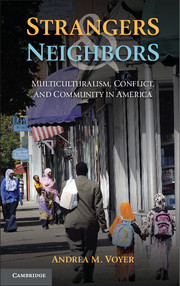Book contents
- Frontmatter
- Contents
- List of Figures and Tables
- Acknowledgments
- Introduction Strangers in a Strange Land
- 1 Ellis Island South and Maine’s Mogadishu
- 2 The Meaning of Somali Settlement and the Boundaries of Belonging
- 3 Being the Inclusive Community
- 4 Disciplined to Diversity
- 5 Familiar Strangers
- Conclusion Cultural Scaffolding
- References
- Index
2 - The Meaning of Somali Settlement and the Boundaries of Belonging
Published online by Cambridge University Press: 05 June 2014
- Frontmatter
- Contents
- List of Figures and Tables
- Acknowledgments
- Introduction Strangers in a Strange Land
- 1 Ellis Island South and Maine’s Mogadishu
- 2 The Meaning of Somali Settlement and the Boundaries of Belonging
- 3 Being the Inclusive Community
- 4 Disciplined to Diversity
- 5 Familiar Strangers
- Conclusion Cultural Scaffolding
- References
- Index
Summary
Community in Crisis
The initial cultural context of reception of Somalis was visible in early public responses to Somali settlement. Emerging narratives included a range of perspectives – from those who decried all immigration to those who championed Somali settlement as the key to a prosperous future for Lewiston. Most characteristic of early official responses to Somali immigration, however, was the perspective that Somali settlement was a burden for the city, that the flow of newcomers was out of control, and that Somalis lacked the self-discipline required if Lewiston was to be successful. This was the understanding presented in Raymond’s letter:
I have applauded the efforts of our city staff in making available the existing services and the local citizenry for accepting and dealing with the influx.
I assumed that it would become obvious to the new arrivals the effect the large numbers of new residents has had upon the existing staff and city finances and that this would bring about a voluntary reduction of the number of new arrivals – it being evident that the burden has been, for the most part, cheerfully accepted, and every effort has been made to accommodate it....
This large number of new arrivals cannot continue without negative results for all. The Somali community must exercise some discipline and reduce the stress on our limited finances and our generosity.
(Raymond 2002)Far from entering the scene as a shocking challenge to local understandings of Somali settlement, Raymond’s letter was consistent with other early assessments of Somali settlement. Somalis were widely believed to be a drain on the city’s coffers and a challenge to historical conceptions that ethnic and linguistic minorities receive limited cultural accommodations. In establishing a distinction between local citizenry and Somali newcomers, public talk emphasized the importance of hard work, self-discipline, and a commitment to community demonstrated by tenure in the area.
- Type
- Chapter
- Information
- Strangers and NeighborsMulticulturalism, Conflict, and Community in America, pp. 48 - 81Publisher: Cambridge University PressPrint publication year: 2013



